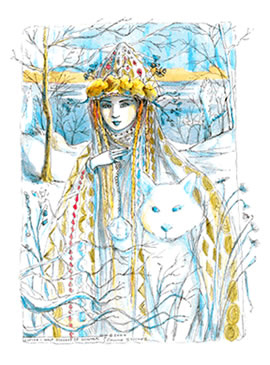|
The Snow Queen in Myth and Literature(continued) By Tala Bar The idea of evil associated with Winter, however, is Christian in
essence, not pagan; winter in northern countries is indeed harsh and
cruel, staying for months under the rule of the white Snow Queen, but
it is never evil. Nature does not know the difference between good and
evil. Winter is an essential part of Nature as much as spring and summer
are, and in southern countries it is summer, which is the harsh and
cruel season of death, while winter is blessed with life-giving rains. In the Scandinavian mythological figure of the Winter and the Snow goddess Skadi, we can see such a difference of ideas. Here is a description of this goddess, taken from the site of Goddesses & Heroines, written by Patricia Monaghan: "The goddess for whom Scandinavia was named dwelled high in the snow-covered mountains; her favorite occupations were skiing and snowshoeing through her domain. But when the gods caused the death of her father, Skadi armed herself
and traveled to their home at Asgard, intent on vengeance. Even alone,
she was more than a match for the gods, and they were forced to make
peace with her. The myth about Skadi and her chosen mate, the God of
Water, explains how impossible it is for snow or ice to exist together
with fresh water at the same time and place in the far north, where
people have to melt snow or ice in order to get fresh water. Skadi's character expresses the aggressiveness of the Northern climate,
but she is never considered evil, which is a term Christianity uses
rather than a pagan attitude. For the early Christians, who lived in
the in the Middle East and the southern parts of Europe, winter is a
blessing rather than a curse. On the other hand, the patriarchal attitude
of that new religion would not accept such a strong female deity as
the Winter Goddess; that deity is not a proper Mother (as nothing is
born in the northern winter), which is the most prominent aspect of
the Goddess accepted both in the south and in Christianity. Modern pagans regard the Snow Queen differently from the way Christianity
does, as can be seen in a poem dedicated to her, called Invocation of
the Winter Goddess, which is taken from "Winter
Solstice Rite":
In his book by the name of The White Goddess, besides the color
of snow, Robert Graves cites many items connected with the color white,
some considered good in the eyes of humanity and others not so. On page
24 there is a memorable description of that goddess: (She) "is
a lovely, slender woman with a hooked nose, deathly pale face, lips
red as rowan-berries, startlingly blue eyes and long fair hair."
This puts her definitely in Northern Europe, as she looks like a proper
Scandinavian woman. But the Goddess can change her appearance and characteristics,
may also appear as a loathsome hag, and has been called by many cultures
The White Lady. The White Goddess, according to Graves, is the same
as the Hebrew Mother of All Living; she is the one who controls life
and death and the prime Goddess of Fertility. That characteristic is reminiscent of the Germanic goddess Holda, who appears in many tales as an ugly old woman. She represented both Fertility and Winter; but her main connection was with Midwinter. Midwinter is the time of the birth of the new Sun, of whom the White Goddess is the mother in her form of a virgin. The color white, as well as the white snow, has always been the symbol of virginity, beside being a symbol of death. Beside Holda's benign aspect of fertility and motherhood, she was also connected with the worship of the female spirits, which appeared in the winter months in England and Scandinavia. Winter was mostly dedicated to spinning, as there was nothing much to do while snow covered the earth, and Holda was known as the Spinner; but, as the Greek myth tells us, the Spinners were the triple goddesses telling the time of life and death of every human being. Christianity has designated Holda the patron of witches, saying that as a heathen goddess she was a demon. This is a fate which befell other pagan goddesses, including the Babylonian Lillith, who was originally Goddess of the Underworld and Wisdom.
|
